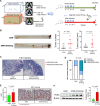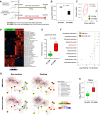Cigarette smoke promotes colorectal cancer through modulation of gut microbiota and related metabolites
- PMID: 35387878
- PMCID: PMC9664112
- DOI: 10.1136/gutjnl-2021-325021
Cigarette smoke promotes colorectal cancer through modulation of gut microbiota and related metabolites
Abstract
Objective: Cigarette smoking is a major risk factor for colorectal cancer (CRC). We aimed to investigate whether cigarette smoke promotes CRC by altering the gut microbiota and related metabolites.
Design: Azoxymethane-treated C57BL/6 mice were exposed to cigarette smoke or clean air 2 hours per day for 28 weeks. Shotgun metagenomic sequencing and liquid chromatography mass spectrometry were parallelly performed on mice stools to investigate alterations in microbiota and metabolites. Germ-free mice were transplanted with stools from smoke-exposed and smoke-free control mice.
Results: Mice exposed to cigarette smoke had significantly increased tumour incidence and cellular proliferation compared with smoke-free control mice. Gut microbial dysbiosis was observed in smoke-exposed mice with significant differential abundance of bacterial species including the enrichment of Eggerthella lenta and depletion of Parabacteroides distasonis and Lactobacillus spp. Metabolomic analysis showed increased bile acid metabolites, especially taurodeoxycholic acid (TDCA) in the colon of smoke-exposed mice. We found that E. lenta had the most positive correlation with TDCA in smoke-exposed mice. Moreover, smoke-exposed mice manifested enhanced oncogenic MAPK/ERK (mitogen-activated protein kinase/extracellular signal‑regulated protein kinase 1/2) signalling (a downstream target of TDCA) and impaired gut barrier function. Furthermore, germ-free mice transplanted with stools from smoke-exposed mice (GF-AOMS) had increased colonocyte proliferation. Similarly, GF-AOMS showed increased abundances of gut E. lenta and TDCA, activated MAPK/ERK pathway and impaired gut barrier in colonic epithelium.
Conclusion: The gut microbiota dysbiosis induced by cigarette smoke plays a protumourigenic role in CRC. The smoke-induced gut microbiota dysbiosis altered gut metabolites and impaired gut barrier function, which could activate oncogenic MAPK/ERK signalling in colonic epithelium.
Keywords: BACTERIAL PATHOGENESIS; BILE ACID METABOLISM; COLORECTAL CANCER.
© Author(s) (or their employer(s)) 2022. Re-use permitted under CC BY-NC. No commercial re-use. See rights and permissions. Published by BMJ.
Conflict of interest statement
Competing interests: None declared.
Figures







References
Publication types
MeSH terms
LinkOut - more resources
Full Text Sources
Medical
Miscellaneous
